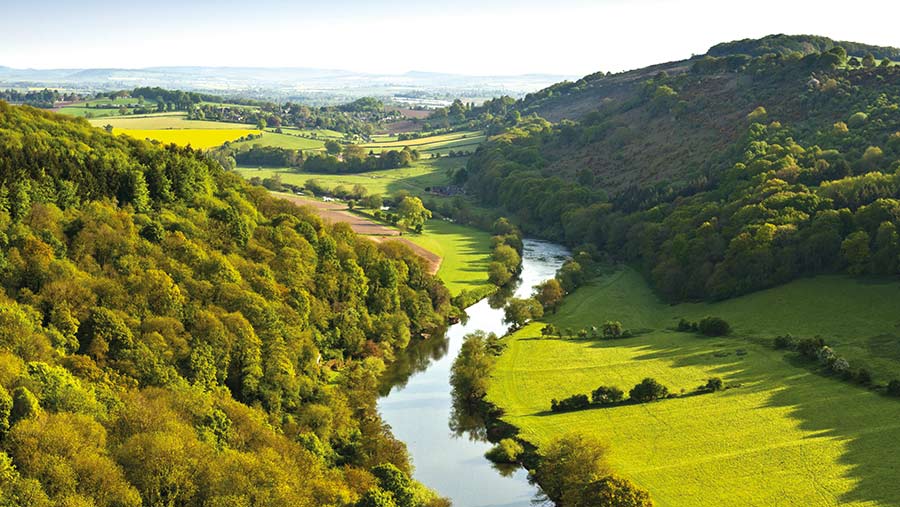Poultry producer pledges to help clean up River Wye
 © Travelwitness/Adobe Stock
© Travelwitness/Adobe Stock Farmer efforts to reduce phosphate losses into the river Wye in Herefordshire have received a significant boost from the poultry sector, after a major broiler production company announced steps to prevent further pollution.
Avara Foods, which has a processing plant in the centre of Hereford, has committed to removing the phosphate from the poultry manure spread on local farmland by investing in interventions such as chemical phosphate stripping technology and pyrolysis plants.
See also: Wye catchment farmers vow to limit phosphate losses
As a result, some 150,000 tonnes of chicken litter will have its phosphate taken out by Avara every year before it is applied to soils, so that the Wye catchment’s annual 2,000t phosphate excess starts to be addressed.
John Reed, Avara’s agriculture director, says that the company is supporting actions that remove phosphate from poultry manure as part of its wider environmental responsibilities, having been made aware of chicken litter’s contribution to the river’s excess phosphate problem.
With soil phosphate input currently exceeding crop demand by 30% in the county, he emphasised that change was also needed from others in the supply chain to prevent losses from agricultural land.
“Collaborative measures are the way forward,” he said. “Avara has already reduced the phosphate levels in broiler diets by 7% and is continuing to look at other ways to improve the situation.
“Now we’re committed to taking this next step with the waste from broiler production, which will be done within two to three years and should help to reduce the mass balance of the Wye significantly.”
There is a range of technologies available to help Avara achieve its goals and a genuine desire to play its part in solving the issue of phosphate levels, he added.
Major development
The move is being seen as a major development by Herefordshire farmers, who hope that other companies in the poultry sector, such as egg producers Noble Foods and Stonegate, will also take action to limit phosphate and soil loss from run-off.
“This is a really welcome move from Avara,” said Martin Williams, who farms on the river Wye at Fownhope. “We’re all having to adapt our practices in the search for workable solutions.”
He adds that growers are also keen that Avara’s nutrient-stripped waste product will remain available in the catchment, as a source of nitrogen and potash, for use in the spring – in line with guidance set out by the Farming Rules for Water.
Anaerobic digestion plants, water companies, large dairy operations and other businesses needed to play their part in improving water quality too, said Kate Speke-Adams of the Wye and Usk Foundation, who is progressing the priority actions identified by the working group.
“Livestock manures, sewage cake and digestate are the main sources of excess phosphate in the river,” she said.
“Avara’s commitment is just one solution that’s been agreed from a whole raft of possible measures. We also need to prevent over-application of livestock manures, look at the suitability of the land it is being applied to, and recognise the threat of climate change.”
What else is being done?
Avara’s efforts will be accompanied by measures at the farm level, including a poultry litter compliance scheme and crop monitoring trials, designed to see whether plants can make use of the stockpile known as “legacy phosphate”.
The compliance scheme involves farmers testing land before they apply chicken litter, so that ground with high P indices is identified and classed as unsuitable for spreading. The cost of the testing will be split equally between the farmer and the manure distributor.
At the same time, spreading protocols are being developed, with the support of the Environment Agency, to increase the accountability of muck use and avoid poor nutrient planning decisions that result in rising soil indices.
Soils with high P indices will be monitored to see if crops are able to access and use the legacy phosphate in them, so reducing the risk of it being lost to water.
As the sandy and silty loam soils of the Wye are more prone to soil drainage losses, farmers will also explore the use of wetland features to buffer land drainage from fields with high indices, to prevent nutrient losses from farmland drains after heavy rain.
Under a previous water protection project, wetlands and margins introduced across 2,700ha of farmland along the River Lugg, a tributary of the Wye, reduced river phosphate levels by a third.
